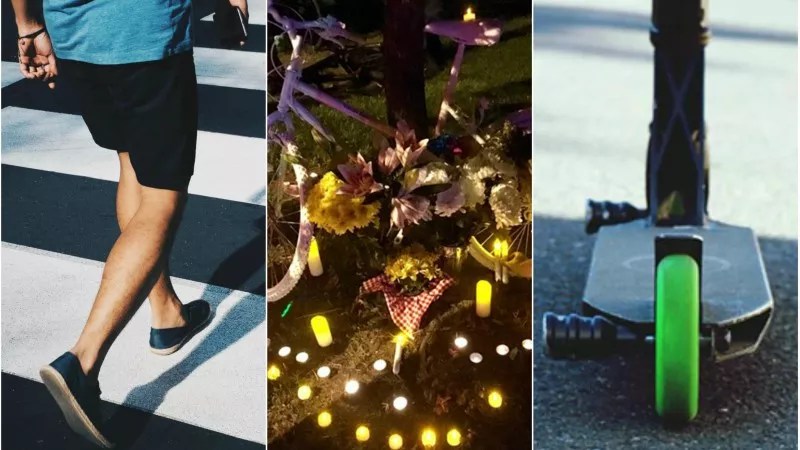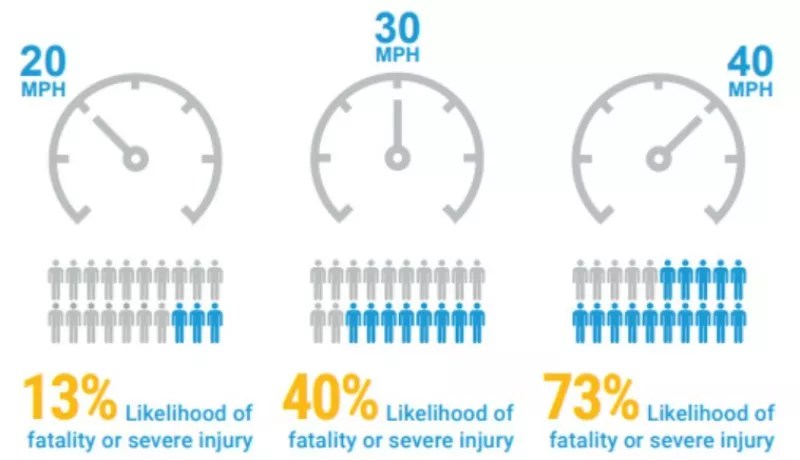
Benjamin Lee for EyeEm via Getty Images/Chris Walker/Marlon Need for EyeEm via Getty Images

Audio By Carbonatix
The tragic passing of Cameron Hagan, a resident of Billings, Montana, who became the first person to die in Denver riding an electric scooter, and a recent Denver Cruisers ride in honor of cyclists killed in the area have focused attention on the dangers faced by those who move about the Mile High City without an automobile. That group includes pedestrians, more than 3,000 of whom were hit by cars in Denver from 2012 to April 2018.
Vision Zero, launched in 2017, is the city’s blueprint to eliminate roadway casualties; its previous projects have included a major reconstruction project on Federal Boulevard from West Seventh Avenue to West Holden Place that was launched last summer. And this month, Denver Public Works will lower the speed limit on five major routes in the city under the theory that reducing the rate at which vehicles travel will help protect everyone not rolling on four wheels.
The operation isn’t a reaction to Hagan’s recent death or the cyclist memorial. As noted by city traffic engineer Emily Gloeckner and Public Works communication manager Nancy Kuhn, it’s been in the works for many months. And while Vision Zero was conceived well before scooters took over Denver city streets (they were introduced in June 2018), Gloeckner believes the approach will benefit riders of those popular devices, too.
“We’re in a place where safety is our top priority,” she says. “Our vulnerable users on the road – pedestrians, cyclists, scooter riders, motorcyclists – are at risk, and we’re doing everything we can to mitigate that.”
Denver, make your New Year’s Resolution Count!
We’re $13,000 away from reaching our $50,000 year-end fundraising goal. Your support could be what pushes us over the top. If our work has kept you informed and connected this year, please consider making a contribution today.
According to Kuhn, the decision to lower speed limits on selected city streets “has a lot to do with crash severity and helping people understand that if they’re speeding, they’re putting people’s lives at greater risk. If you’re going above the speed limit, you’re more likely to injure somebody.”
These hazards ratchet up quickly even at speeds that most drivers consider modest. As seen in the graphic below, the chances of someone being killed or severely injured in a crash triple from 20 mph to 30 mph, and at 40 mph are well over five times greater than at 20 mph.

With this in mind, Public Works collected speed data at 37 locations around the city and chose five of them, including four on the city’s high-injury network (the Denver corridors with the highest number of fatal and injury crashes), on which to lower the speed limits. No decision has been made about the other 32 locations, but many, if not most, of them could eventually see lower speed limits, too.
Here are the five streets where speed limits are being reduced, a process that should be completed by month’s end:
• West Evans Avenue from Federal Boulevard to Huron Street (35 mph to 30)
• Cherry Creek Drive South from University to Colorado boulevards (35 mph to 30)
• 1st Avenue/Steele Street/Cherry Creek Drive North/Alameda Avenue from University to Colorado boulevards (35 mph to 30)
• Peoria Street from 47th to 39th avenues (40 mph to 35)
• 56th Avenue from Quebec Street to Tower Road (45 mph, the speed in most locations, to 40)
Of course, many people routinely exceed speed limits – and Gloeckner says that these changes take that behavior into account.
“We can post the speed limit at 5 mph below what most people are traveling and still be compliant with federal guidelines,” she notes. “If we follow up and see people are not complying with the posted speed limit, there are new elements we might introduce, like the bollards we use in protected bike lanes, to visually narrow the roadway, and that can result in lower speeds.”
Given the deadly toll on Denver streets, a multitude of tactics may be necessary. Among the online tools available through Vision Zero is a new data dashboard that shows the locations of fatal and severe-injury crashes since 2013, plus a slew of visuals like the ones below. The graphic on the left shows how many fatal or serious-injury crash events have taken place in each year since 2013. To date for 2019, there have already been 342, suggesting that the number could exceed the 558 in 2017 and 564 in 2018.

Another just-announced Public Works initiative involves the deployment of so-called feedback signs – electronic monitors that flash driver speeds – on city vehicles.
“If we have a fleet of vehicles in the field, we’ll attach the signs to those vehicles,” Kuhn says of the program, which should be operational by October 1. “It will be stationary, but when the units are parked alongside the road, it will show drivers how fast they’re going, which will hopefully slow them down and improve safety in the work zones. We thought, why not make use of this asset and give some driver feedback as well?”
Still, persuading drivers to travel more slowly could be a challenge, particularly given the rising volume of complaints about terrible traffic in the city – and Gloeckner says she sympathizes. “This is an ongoing program, and we’re going to continue to look at opportunities to lower speed limits on our roadways,” she stresses. “So we’re just going to have to ask for everyone’s patience.”
Some have suggested that Vision Zero’s mission to completely halt every road death in Denver, be it a scooter rider, cyclist, pedestrian or motor-vehicle passenger, is unattainable. Responds Gloeckner: “It has to be our goal. But we can’t do it just by engineering. We’re seeing about 50 percent of accidents can be mitigated by engineering tools, but the other 50 percent are behavioral. So we need education, too. We have to let people know that slowing down will save lives.”